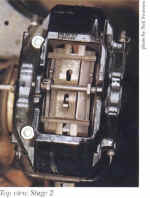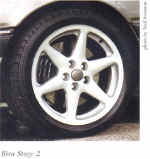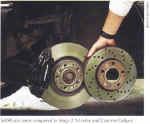



Reprinted with permission from the Quattro Quarterly, the official publication of the Audi Quattro Club USA
GIVE ME BRAKES TOO, BUT ON A BUDGET
by Jon Linkov
NO MATTER HOW MUCH OR HOW little power your car has, one thing is for sure: You always have to stop. Whether it's on the track heading toward a 180 degree turn at 120 mph, or on the street trying to avoid a sedan pulling out in front of you, we've all had to stomp on the brakes at least once. And, undoubtedly, some of us have become convinced that our cars are just a little bit under-braked for our needs.
There are solutions, but they're divided into two categories: one for the fiscally challenged and one for the fiscally secure. Now, let's agree that cars are expensive and, if cost was REALLY an object, we'd all be driving econoboxes. Yet there are Audi fanatics with gobs of disposable income and those who have to put a cap on their spending.
The fiscally secure have a wide variety of options for their brake improvements, including Alcons and the venerable "Big Reds," like the type Paul Rivera put on his car (quattro quarterly, Fall 1998 & Summer 2000). Kits such as these start in the low $2,000 range and rocket upwards. Internet lore and third-hand stories abound of people who installed $6,000 front-brake kits on their street cars!
On the other end, the fiscally challenged have fewer options. For about $100 you can buy slotted or drilled rotors; $10 gets you high-temperature brake fluid; and $150 to $200 will get you racing brake pads. That's it, either $300 or $2,000. But a few Audi enthusiasts have come up with a solution for those who aren't quite fiscally challenged, but are still working on a budget.
BIRA.ORG (Braking Improvement Research Association) grew out of discussions between Audi owners Greg Amy and John Karasaki in 1999. They spent numerous hours on-line, discussing John's idea to incorporate a better braking system on the S4/S6. They tried to figure out how to provide a low-cost braking system that would be easy to install and be good for both stop-and-go city traffic and driver-education events. "Low cost" meant parts would have to be off the shelf and wouldn't require costly rebuilds after each track season. The original project was to design a system that would work on the S4/S6/200tq/V8 front struts. It was out of these discussions that BIRA.ORG was born, after John decided to stop working on the project.
The BIRA system is a combination of Audi rotors, Porsche monobloc calipers and a bracket. This bracket is the key component of BIRA's systems. Using AutoCAD Greg designed a bracket that allows the new Porsche monobloc calipers to bolt onto the Audi front struts, clamping over A8 rotors. A wide variety of brake pads are available for the Porsche calipers.
BIRA supports two braking systems – System 1 and System 2. System 1 is for cars with 16-inch wheels and utilizes Porsche Boxster monobloc calipers and Audi A8 312 x 25 mm rotors. System 2 is for cars with 17-inch wheels. It employs Porsche Carrera monobloc calipers with the new 323 x 30 mm rotors found on the twin-turbo S4.
Currently, owners of the 1992-1995 Audi S4/S6 (and any car that has the S4/S6 front suspension), 5000, 200, 100, Ur-quattro, A6, A4, VW Passat and TT can fit either system on their cars.
In order to install the brackets, buyers must join BIRA and participate in a group-buy of the brackets. BIRA isn't a tuner or a manufacturer of brakes, just an association of members. According to Greg Johnson, who acts as a legal advisor to BIRA, "[The association] does not sell brackets in the stream of commerce. In order to obtain BIRA brackets, one must become a BIRA member. All BIRA members have contractually agreed not to sue one another or the bracket designer; they have expressly and knowingly assumed any risk associated with the brackets; and they have agreed not to steal the bracket designs."
There's a one-time, non-refundable membership application fee of $20, which gives members access to any and all of BIRA's materials and access to the members-only area of their Web site. Amy admits he "dislikes" the “legal stuff” but “it's the only thing we could come up with that would allow us to share these brakes with others, without potentially losing everything. We could have incorporated and purchased liability insurance, but all of that would have driven the price back into the several thousand-dollar range, which defeated the whole purpose." As of this writing, over forty people have joined BIRA.
Johnson says members indicate System 1 costs around $1,100 and System 2 about $1,300. All of the brake set-ups allow slotted rotors and aftermarket (non-Porsche OEM) pads to be used, at additional cost. Aftermarket brake pads generally add about $60, and slotted rotors add around $70. On System 2, red calipers (from the Boxster S) can be substituted, and cost about $50 additional per caliper. Perhaps best of all is the fact that it is relatively easy for members to install the brakes. According to Amy, "If you can change brake calipers, you can install either system."
All of the parts for the two systems, except the BIRA bracket, are available at either a Porsche dealer or aftermarket companies. BIRA merely came up with a way to incorporate Porsche calipers onto Audi struts.
BIRA has a number of member/owner testimonials on its Web site attesting to the superior feel and performance of the new calipers and rotors. Remember, these two systems use proven brake calipers that are meant to haul world-class sports cars down to a safe, controlled stop.
I took Greg's 200tq out for a short drive on local roads in Connecticut, and was quite impressed with the pedal feel and stopping ability of the brakes (system 2). I can understand why Porsche owners rave about their brakes and why Greg and John use Porsche calipers.
To find out more about BIRA, visit their Web site at http://www.bira.org. On the site you can read testimonials from customers, view the growing wheel-fitment list, and learn how you can join BIRA.ORG and improve your car's brake performance.